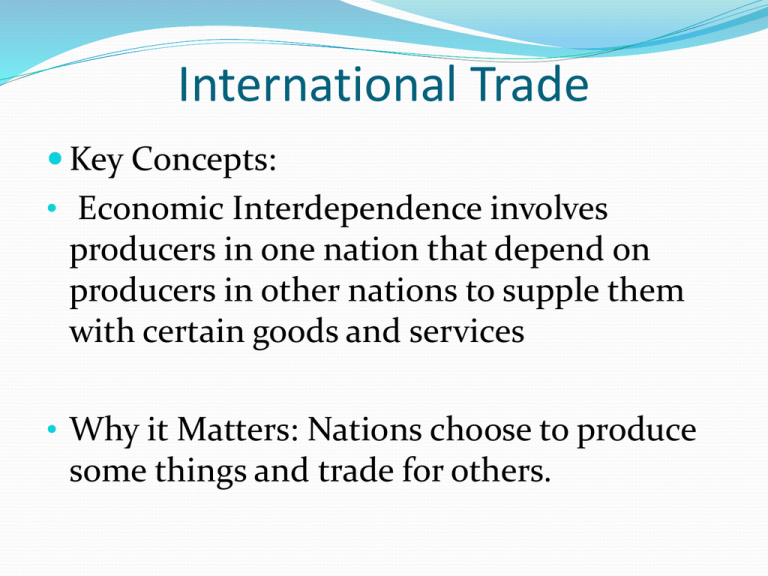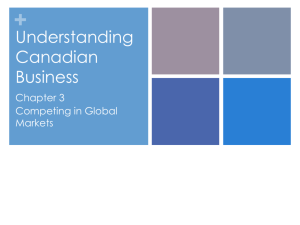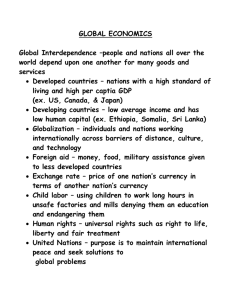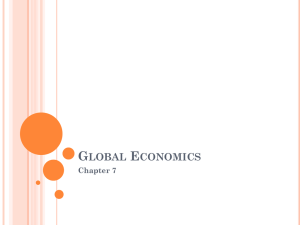Trade Barriers
advertisement

International Trade Key Concepts: • Economic Interdependence involves producers in one nation that depend on producers in other nations to supple them with certain goods and services • Why it Matters: Nations choose to produce some things and trade for others. Resource Distribution and Specialization Nation’s economic patterns based on factors of production it has Patterns change over time (U.S. agriculture to technology) Specialization occurs when narrow range of products are made; this leads to: Increased productivity and profit Economic interdependence-reliance on others for products not made Specialization Costa Rico exports bananas; wet climate bananas need Relatively low wages are beneficial Production is labor intensive New Zealand exports wool, lamb and mutton Has temperate climate, H2O, open grasslands needed for grazing Has low population density, scientific breeding, mechanized processing David Ricardo: Comparative Advantage Trading in Opportunity English Economist 1772-1823 In his time: international trade was based on absolute advantage Ricardo showed nations can benefit from comparative advantage Produce products it can make at lower opportunity cost that others Absolute and Comparative Advantage Absolute advantage: nation’s ability to make product more efficiently Due to uneven distribution of production factors in different areas Comparative advantage: ability to produce at lower opportunity cost Absolute cost of product not important, just opportunity cost Absolute and Comparative Advantage Absolute Advantage Examples Australia produces more iron ore and steel than China with same labor Australia has absolute advantage Before Ricardo, logic held Australia should not trade for either Comparative Advantage Examples Law of comparative advantage: countries gain when produced items they are most efficient at producing And are at the lowest opportunity cost If Australia’s ratio of steel to iron ore is 1:15 tons and China’s is 1:3, China has comparative advantage in steel production Advantages of Free Trade If China, Australia specialize, set trade ratio steel to iron ore 1:4 China gets 4 tons of iron ore for 1 of steel Australia gets 1 ton of steel for 4 of iron ore: cost 5 before Specialization, trade raise nations’ production ratios, world output Increased output is mark of economic growth International Trade Affect the National Economy Exports: goods and services produced in one country, sold in others Imports: products produced in one country, purchased by another Costs and benefits of international trade vary by nation Economists examine impact of exports and imports on prices and quantity. Impact #1: Exports on Prices and Quantity If a country begins exporting product, foreign buyers increase total demand Demand curve shifts right, sets higher equilibrium price Higher prices at home offset by more jobs and income Created by production expanded to meet demand Impact #2: Imports on Prices and Quantity Imports shift supply curve right, lower equilibrium price Lower prices lead domestic producers to offer less of the product Improve efficiency, worker productivity, customer service Trade gives consumers increased selection of goods , lower prices Gives producers new markets, chance for more profit The U.S. in the World Economy U.S. is world’s largest exporter; exports more services than imports Tourism, transportation, architecture, construction, information systems Also world’s largest importer; imports more goods than it exports Oil and refined oil products, machinery, raw materials Main trading partners: Canada , China, Japan Trade Barriers Most nations pass trade limit laws to protect domestic industries Laws lead to higher prices, economic retaliation by other nations In long run, industries can only be saved by becoming competitive Trade restrictions are basically a political issue Trade Barriers Types of Barriers Trade barrier: law limiting free trade among nations; most mandatory Quota: limits on the amount of a product that can imported Dumping: sale of product in other country at lower price than at home Hurts domestic producers; gives consumers lower prices Type of Trade Barriers Tariff: fee charged for goods brought from another country Revenue tariff: tax on imports, specifically to raise money Rarely used today Protective tariff: tax on imported goods to protect domestic products Raise price of goods more cheaply elsewhere Impact of Trade Barriers Trade Barriers may temporarily save domestic jobs Lack of competition promotes inefficiency, higher prices Trade limits can lead to trade war: Succession of increasing trade barriers between nations Impact of Trade Barriers #1: Higher Prices Trade barriers raise prices or keep them high In 2000, U.S. & Japan set tariffs on S. Korean semiconductor chips Korean and domestic chip prices went up in U.S. & Japan #2: Trade Wars Trade wars often result from disagreements over quotas or tariffs Can result over other issues EU banned U.S. hormone-treated beef, U.S. set 100% tax on many EU foods Arguments for Protectionism Protectionism: use of trade barriers to protect domestic industries Purpose: to protect jobs, national security, infant industries (new industries unable to compete with larger, established competitors) Arguments for Protectionism #1: Protecting Domestic Jobs U.S. workers upset over jobs lost to countries with cheaper labor Trade barriers generally protect inefficient production, prices higher Laid-off voters influenced government to fund job training programs Arguments for Protectionism #2: Protecting Infant Industries Protection expected to allow new industries to grow until competitive Used by developing nations to keep out goods from developed countries Critics say freedom form competition maintains perpetual infancy; And need for perpetual support Arguments for Protectionism #3: Protecting National Security National security affects industries considered vital for safety Energy industry considered vital by most nations Political differences exist over which industries are truly vital 2006 Dubai forced to abandon deal to operate several port facilities Critics doubted security concerns, worried over interference with trade Foreign Exchange Market Rates of Exchange In 1800’s, early 1900’s gold standard determined value of currencies Fixed rate of exchange: nation’s currency constant in relation to others Post WWII to 1970’s: currencies pegged to USD: 1 oz gold = $35 Flexible rate of exchange (floating rate): changes along with currency’s supply, demand Regulates foreign exchange, balancing imports and exports Strong and Weak Currencies Trade-weighted value of the dollar - international value of U.S. dollar Measured by Fed Weak dollar makes imported goods more expensive Easier for domestic goods to compete Exports become cheaper, easier to sell Strong U.S. Dollar Balance of Trade Balance of Trade: difference between value of imports and exports Balance of payments: all transactions between nation and rest of world Includes government and private transactions, both trade and investment Trade surplus: nation exports more that imports; favorable balance Trade deficit: nation imports more than exports; unfavorable balance Balance of Trade U.S. –China Trade China undergone one of the most rapid industrialization in history Has pegged yuan at fixed rate vs. dollar; keeping yuan weak Made U.S. top destination for Chinese exports China has record trade surplus of $200 billion with U.S. The U.S. Trade Balance 1770-1870: U.S. had deficit in products; surplus in capital investments 1870-1920: paying back debt; was exporting > importing 1920-1945: had surplus in exports; deficit in foreign investment 1945-1980: deficit in merchandise; deficit in foreign investment Today: surplus in foreign investment; merchandise deficit Modern International Institutions Regional and World Organizations Free-trade zones: areas where nations trade without protective tariffs Customs unions: agreements that abolish trade barriers among members Establish uniform tariffs for non-members Some trade groups called common markets The European Union 1957: six European nations created Common Market: became EU in 1993 European Union: economic and political union; no barriers for members Euro: currency of the EU; used by 12 of 27 member nations EU has 20% of global exports and imports; worlds biggest trader Sets low tariffs; wants to remove all barriers to international trade North American Free Trade Agreement Adopted 1994 Also known as NAFTA Phases out trade barriers between Canada, Mexico & U.S. Has led to specialization, efficiency, expanded markets, new jobs Also competitive advantage over EU and Japan All countries have had economic gain Trade has more than doubled Other Regional Trade Groups Various groups formed to specialize, promote free trade, stay competitive Mercosur: South America ASEAN: Southean Asian Nations APEC: Asian Pacific Market SADC: South Africian Development Community OPEC (Organization of Petroleum Exporting Countries) OPEC is a cartel Group of producers controls production, pricing, marketing of a product Other Regional Trade Groups World Trade Organization 1944 Allied nations formed General Agreement on Tariffs and Trade (GATT) WTO formed in 1995 by nations that follow GATT Negotiates, administers trade agreements Resolves disputes Monitors policies of 149 members Gives support to developing countries WTO successful to varying degrees Multinationals Bring Changes Key Concepts Multinational corporations affect many different nations Must deal with different sets of tariffs, labor restrictions, taxes Often bring jobs and technology to developing nations Boost overall levels of international trade International Trade W/in Multinationals Intrafirm trade is trade between various divisions of a multinational Exchange of goods between two parts of the company Coordination of production between parts of the multinational Materials or parts sent to overseas affiliate count as exports Intrafirm imports count as imports in balance of trade Multinational Example World Wide Cellular Mines raw materials in Australia Manufactures phones in South Korea Markets phones in Europe Provides customer service from India






